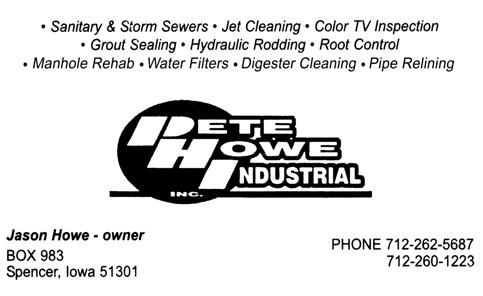
4 minute read
When It Doesn’t Surface
By Mike Moeller, SDARWS Circuit Rider
Many communities across the state of South Dakota are suffering from an epidemic of water loss. The reason for these losses often vary greatly from one community to another, but one that is the most common is leaks in the systems that are under ground.
Advertisement
One of the misconceptions from years gone by is that if there is a leak in a pipe, no matter where it is, it will eventually come to the surface. This theory may work in some areas of the state where the soil is very dense and made up of mostly clay, but if there is one vein of gravel where the water passes by, it will take the easiest path and follow the gravel vein, and may never come to the surface. Another difference that can be seen in South Dakota is the difference from East River to West River.
East River – The east side of the state has many different types of soil ranging from heavy clay to sugar sand. These different types of soil have many different effects on a water leak – and how it will travel to the surface – if it ever does. When the soil is heavy clay, more than likely the leak will come to the surface; but if there is a gravel or sand vein in the clay, the water will take the path of least resistance and may never come to the surface. East River soils may vary from one extreme to another within just a few feet.
West River – The land west of the river also has many different soil types from sand by the river to sandy loam in the western plains and rocky mountainous in the far west. All of these soil types are porous enough that water doesn’t usually surface when there is a leak in a pipe.
$$$$$– Water that is being lost out of a system can be very expensive to a community. Communities around the state are doing a better job today of tracking this loss than in years past. The reason for this is the understanding that the water that is being bought by a community is treated by their water plant at a cost to the community, and when it does not make it to a consumers water meter to be sold, then the community becomes the one paying for it without reaping the benefit. An example of this would be if a community had a water loss of 25 gallons per minute from five different leaks it would add up to a loss of just over 1 million gallons per month. The American Water Works Association calculates that the average cost of tap water is $.004 per gallon. The cost to the community would be $4,000.00 per month for water that was paid for but not getting that money back from consumers.
Finding the Leak– There are many methods for finding a leak. Some of the methods used by South Dakota Association of Rural Water Systems are: j System pressure match and flow monitoring with a trailer mounted pump system. j Listening devices that listen for sound in a water main. j Listening devices that a circuit rider uses to listen to the ground.
Leaks on a water main or service line all make noise. This noise can be compared to water being sprayed out of a garden hose or even the sound made when you turn on the kitchen sink. Some of the difficulties with listening for the system leaks are of course the obvious of six feet of dirt over it, and then the type of pipe. If the pipe is metallic, it will carry sound much better and farther than plastic pipe. Leak detection with listening type equipment is much more difficult on plastic pipe, and sometimes the leaks are not detected.
Another type of detection equipment used is to inject helium or hydrogen into the water main and to use a “sniffer” while walking along the top of the main to sense the gas that was injected in the main. The theory is the gas is lighter than air and will float out of the ground above the leak.
In conclusion, water leaks can be very expensive to a community and can be very hard to find. There is equipment that is made to aid in the leak detection process. Water loss is not only water loss but is money lost. Keeping good records on the amount of water purchased or treated versus the amount of water sold is a good practice to have, and will keep the city budget out of the red. If your system needs assistance with leak location, please give SDARWS a call at 605-556-7219.
Reprinted with permission from the South Dakota Association of Rural Water Systems.











